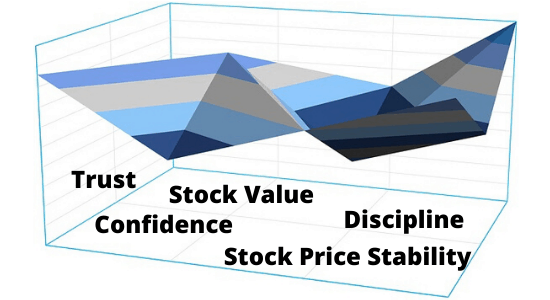But Cash Dividends Are The Best Type Of Dividend!
I like cash dividends, but a dividend investor should understand the different types of dividends.
So, let’s dive into the various forms of dividends. And some other key information that all dividend investors should understand.
Information about the issuance of dividends. In order to make money from dividends. Because making money from dividends is our goal!

5 Types Of Dividends That Companies Can Issue
- Cash dividends
- Stock dividends
- Property dividends
- Scrip dividends
- Liquidating dividends
Some will say there is another type of dividend, called homemade dividends. But this type of dividend is outside the scope of this article.
We will discuss each of these in more detail. But first, let’s make sure we understand exactly what a dividend is? And before that, just one more thing to help you out on your dividend investing journey…
You can find all of our dividend investing posts neatly organized and at your service. Here, in our library of dividend investing articles.
What Are Dividends?
Now, let’s make sure we all know what a dividend is. Later, I will have more on exactly how dividends work at different companies.
Dividends are distributions of economic value. And dividends are paid by a company to owners of its stock.
Distributions can come in a variety of forms. Furthermore, they are made from past profits. Finally, dividends are an important way for stockholders to share in a company’s financial success.
Now, we know what a dividend is. So, let’s discuss the 5 types of dividends in more detail.
Disclosure: At no cost to you, I may get commissions for purchases made through links in this post.
Types Of Dividends: Fully Explained

Yes, a dividend is a distribution that has economic value. But, the value can be transferred in several different forms. Let’s go through the various forms of dividends now…
1. Types Of Dividends: Cash Dividends
First of all, let’s answer an important question. What is a cash dividend? I think we all understand good ole cash.
Fortunately, cash is the most common type of dividend distribution. This type of dividend provides the basis for dividend investing strategy.
Once a cash dividend is received, it is the investor’s choice what to do with it. Spend it, save it, or reinvest in the stock that paid. Or, another type of investment.
Next, let’s talk about cash dividends vs. stock dividends.
2. Types Of Dividends: Stock Dividends
Versus cash dividends, a company may choose to give its shareholders additional stock. On the surface, this sounds nice. But it has little economic meaning to an investor.
Why is that? Because the effect of stock dividends is to just keep an investor whole. With no net gain.
Because he or she still holds the same percentage ownership in the company. Also, the value of the company remains the same.
So, there is little to no value transferred to a stockholder. As compared to receiving regular cash dividends. Furthermore, no value has been created at the company.
What about a stock dividend vs. a stock split?. While a stock dividend is typically less than 25% of the total number of previous shares outstanding. Stock splits can create many more times the number of shares outstanding. Or, even more.
Using a dividend example, Apple recently split its shares 4 for 1. As an owner in Apple stock at the time of the split, you owned 4 times as many shares. But the shares revalued in the market at 25% of the pre-split price.
Finally, stock dividends are sometimes referred to as a dividend in kind. Or, distribution in kind.
Resource: Be sure to buy & sell your stocks for free using the Webull app
3. Types Of Dividends: Property Dividends
In rare cases, a company paying a dividend does so in the form of property. Or, some type of physical asset.
The company records the dividend on their books at the fair market value of the asset. Once received, the investor can do with the asset as they please. Keep it, sell it, store it, or destroy it.
This sounds like a hassle to me. I’m glad that property dividends are rarely issued. I’ve been a dividend investor for nearly 20 years and have never received one!
4. Types Of Dividends: Scrip Dividends
Companies typically issue scrip dividends instead of a cash dividend. Why is that?
Because they do not have sufficient funds for paying cash dividends. So instead, they issue a scrip dividend. A scrip is essentially a promissory note, or I owe you (IOU). That promises to pay shareholders at a later date.
Therefore, a scrip dividend creates a liability on a company’s books. Just like a cash dividend.
But unlike a cash dividend, the note payable will be held for a longer period. That timing is subject to the company’s cash availability in the future.
5. Types Of Dividends: Liquidating Dividends
A board of directors may desire to return capital originally contributed by shareholders. When this occurs, it is called a liquidating dividend. Also known as a return of capital.
A liquidating dividend may lead to the shutting down of the business. This is not common. And certainly not the type of businesses I want to invest in.
On the other hand, a return of capital dividend is more common. But, I do not understand companies that pay dividends classified as a return of capital.
If I wanted my capital returned, I wouldn’t have given it to them in the first place. Therefore, I look to invest in companies that pay cash dividends from current profits and cash flows!
What Type Of Dividend Is Best?

Cash Dividends: This is no contest. I’m suggesting the best type of dividend is a cash dividend.
As I mentioned, an investor receiving cash dividends can do with that cash as they please. Cash is an instant medium of exchange. And the value of cash is easy to determine.
Furthermore, I will use the process of elimination. To suggest why the other types of dividends are sub-par. In comparison to a cash dividend.
Stock Dividends: They have no economic value. Neither to the company or the investor.
Property Dividends: I have no interest in a company’s physical assets. What would I do with it? And how would they get it to me anyway?
Scrip Dividends: This is a loan. If I wanted to loan money to a company, I would invest in its bonds.
Liquidating Dividends: I have no interest in investing in a company that may shut down. Or return the capital I decided to invest in the first place.
To emphasize. When I’m trying to find dividend-paying stocks. The only type of dividend that interests me is one that is paid in cash.
I can make a good argument for cash dividends. Furthermore, the 4 other types of dividends may be irrelevant to investors.
Next, let’s talk about how the types of dividends are classified. For tax purposes.
Classification Of Dividends For Tax Purposes

Dividend types are classified in 1 of 2 ways for tax purposes.
Qualified Dividends
Most dividends are qualified dividends. This means the dividends are taxed at a lower rate.
To be eligible, certain requirements must be met by the company paying dividends. And the investor must hold the stock for a minimum time.
But let me generalize. Buy and hold most U.S.-based stocks paying a dividend. Then you will usually receive a qualified dividend.
A dividend that is eligible for preferential tax treatment. The specific tax requirements are outside of the scope of this article.
Non-Qualified Dividends
Otherwise, a dividend is non-qualified. And subject to higher ordinary income tax rates. Because of this, sometimes these dividends are called ordinary dividends.
Resource: Manage your total financial picture with Personal Capital
Issuance Of Dividends On Different Types Of Stock

Finally, dividends are paid on 2 types of stock.
Common Stock Dividends
Holders of common stock have the right to vote on important company matters. Like electing members of the independent board of directors. The board represents your interests as a stockholder. Also, the board must approve the amount and the timing of dividend payments.
Preferred Stock Dividends
While preferred stock does not have voting rights. It has other benefits. Preferred stock is a hybrid security that has a mix of bond and common stock traits.
The investor doesn’t have the upside potential of common stock. But in exchange, the investor normally receives a substantial cash dividend. Also, in specific situations, the holder receives preferential treatment above common stockholders on the receipt of those dividends.
Before we move on to more information about the issuance of dividends. Let’s sum up what we have learned so far…
There are 5 types of dividends. Each is classified in 1 of 2 ways for tax purposes. And dividends can be distributed on common or preferred stock.
This may seem complex. But it doesn’t have to be.
Because most dividend stocks that dividend investors focus on:
- Pay cash dividends on common stock
- Are considered qualified for tax purposes
Most corporations and investors, including myself, ignore everything else. When it comes to the different types of dividends.
Issuance Of Dividends On Different Types Of Investments

Our focus today is on the different types of dividends paid to common stockholders. And to a lesser degree, owners of preferred stock.
But, I want to mention that other types of investments pay dividends. A couple of popular investments that come to mind. There are some great dividend-paying exchange-traded funds and mutual funds too.
Frequency Of The Different Dividend Types
Types of cash dividends and other dividends, no matter their type, are paid at different times. Let’s discuss…
Dividend Frequency: Regular & Recurring Dividends
First of all, we have regular and recurring dividends. As the description suggests, they are dividends paid consistently.
Furthermore, companies use different dividend payment frequencies and patterns.
Finally, the most typical dividend payment patterns are quarterly, monthly dividend payments, or distributions made twice per year.
Dividend Frequency: Special Dividends (Also Called One Time Dividends)
A special dividend occurs on an irregular basis. Typically when a company has had a very profitable year.
And they want to share those profits with stockholders. Investors are typically pleased to collect dividends like this. Because it is a sign of business success.
Another reason a company pays a special dividend is what is known as a dividend recapitalization. Also, called a dividend recap.
A dividend recap occurs when a company takes on debt. And uses the cash received from that debt to pay owners a special dividend.
This practice is more typically done in privately held companies. It is a way of rewarding shareholders and transferring business risk to those who lend the company money.
Private equity firms often use this strategy. With the companies. they hold in their investment portfolios.
It should go without saying. But most dividend investors prefer frequent and consistent dividend payments. As opposed to special dividends.
Regardless of the type of dividend, why do companies pay them? Let’s discuss that next…
Why Do Companies Pay Dividends?

What is the underlying concept of dividend payments? Well, there are 6 primary reasons why companies pay dividends. They…
- Have profits & they must be allocated in some way
- Desire a balanced approach to allocating those profits
- Wish to attract new and maintain current investors
- Want to provide investors with a return on their investment
- Believe paying dividends demonstrates their financial strength
- Want to provide underlying support for the stock price
So, as we can see, companies paying a dividend do so for a variety of reasons. What is the most important reason for a dividend investor? Dividends provide a means to reward shareholders, normally with cash.
But there is another popular way companies reward stockholders. That is share repurchases. They are also referred to as share buybacks.
Resource: Get quality dividend stock recomendations from Simply Investing
Dividends Vs. Share Repurchases
Some companies prefer returning profits to shareholders by repurchasing their shares in the stock market. Also, many companies do both. That is pay dividends and repurchase their shares.
Assuming you hold on to your shares, after a share repurchase, you own a greater percentage of the company. Share buybacks also increase earnings on a per-share basis. Because fewer shares are outstanding.
And, all things being equal. Buybacks create higher earnings per share that translate to a higher stock price.
But, you may ask, if share repurchases result in a higher share price, why would a company pay dividends? It is because a compounding stream of dividend payments can also increase the value of a stock.
Impact Of Dividends On Stock Valuation
There is a popular dividend stock valuation model called the Gordon Growth Model. The Gordon model suggests the value of a stock based on the present value of its future dividend payments.
The Gordon model works off the concept called the time value of money. To sum it up, the higher a company’s dividend is today. And the more it is expected to increase the dividend in the future. Then the higher the intrinsic value of the stock.
One more concept of dividend payments to understand. Then I will summarize and wrap up.
Dividend Policy
We now know that many decisions go into making a dividend payment. Decisions like the type of dividend, amount, timing, and frequency.
To make dividend decisions, companies establish a dividend policy. And a set of dividend distribution guidelines. The guidelines are the rules for paying dividends to shareholders. And the dividend policy must be determined in context with other cash needs of a business.
Types Of Dividends: Wrap Up & Summary

Now you know the 5 types of dividends.
- Cash dividends
- Stock dividends
- Property dividends
- Scrip dividends
- Liquidating dividends
Of the various forms of dividends, cash dividends are by far the most popular. And, in my opinion, the best type of dividend an investor can receive for earning monthly dividends.
Also, these examples of dividends are classified as qualified or non-qualified for tax purposes.
Dividends are paid on both common and preferred stock. They are also paid on other types of investments. Payments may be made regularly, or on a special, one-time basis.
Companies pay dividends to reward shareholders. They can also reward shareholders in other ways. By using their cash to repurchase shares of their stock from the open market.
Both dividends and share repurchases have a positive influence on the stock price. But I prefer cash dividends. Because dividends reward long-term ownership in a stock.
On the other hand, share repurchases most directly benefit those investors cashing out. Why? Because they are selling their shares back to the company.
Finally, the types of dividends a company pays are determined by its dividend policy.
More Reading On Dividend Types & Dividend Investing
- Dividend portfolio tips to consider
- Investing in utility stocks for high paying dividends
- Get stock dividends in February, May, August, and November
My Favorite Dividend Investing & Personal Finance Resources
- Trade stocks for free with the Webull app
- Get stock research from Morningstar
- Get dividend stock recommendations from Simply Investing
- Manage your finances for free with Personal Capital
Author Bio: Tom Scott founded the consulting and coaching firm Dividends Diversify, LLC. He leverages his expertise and decades of experience in goal setting, relocation assistance, and investing for long-term wealth to help clients reach their full potential.